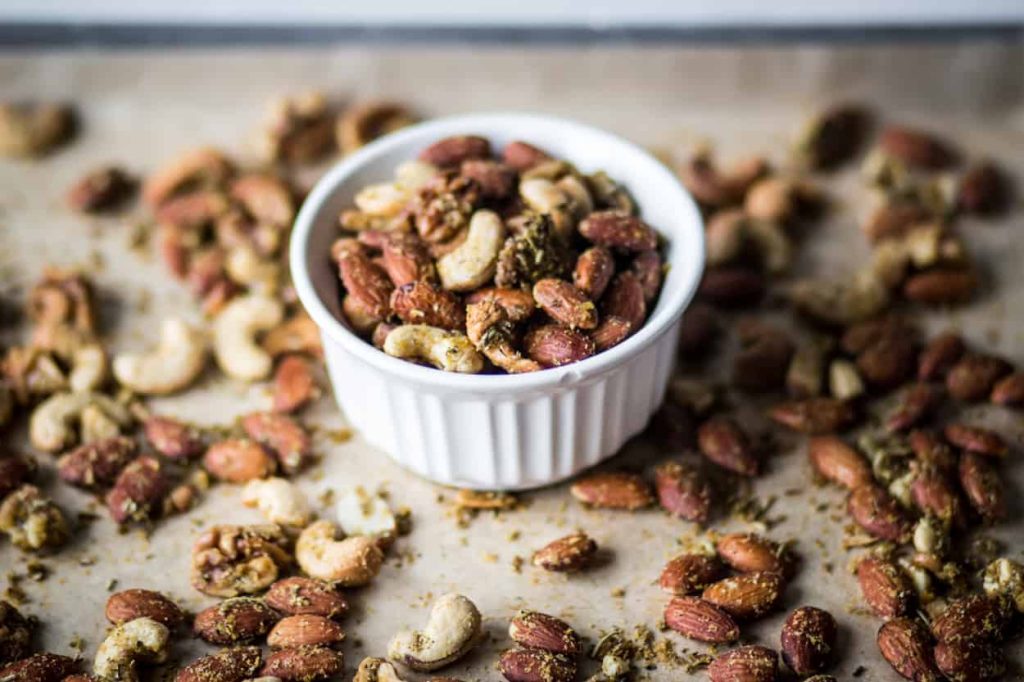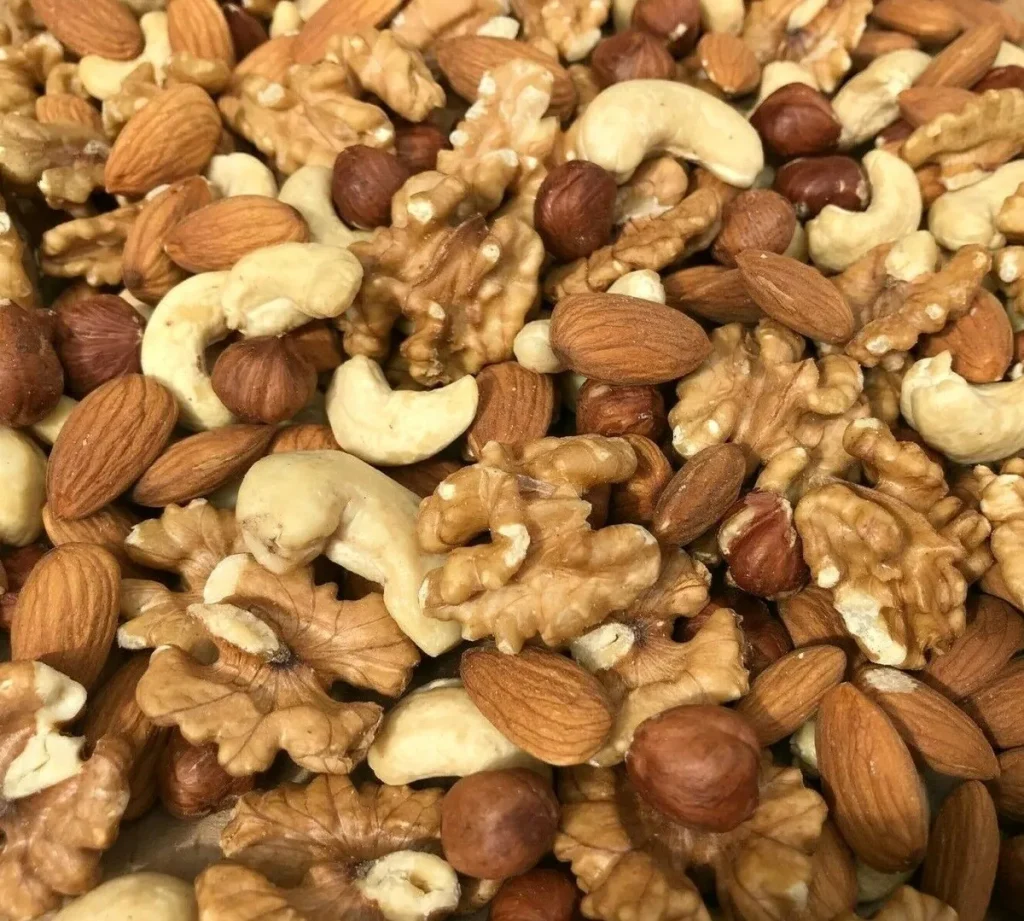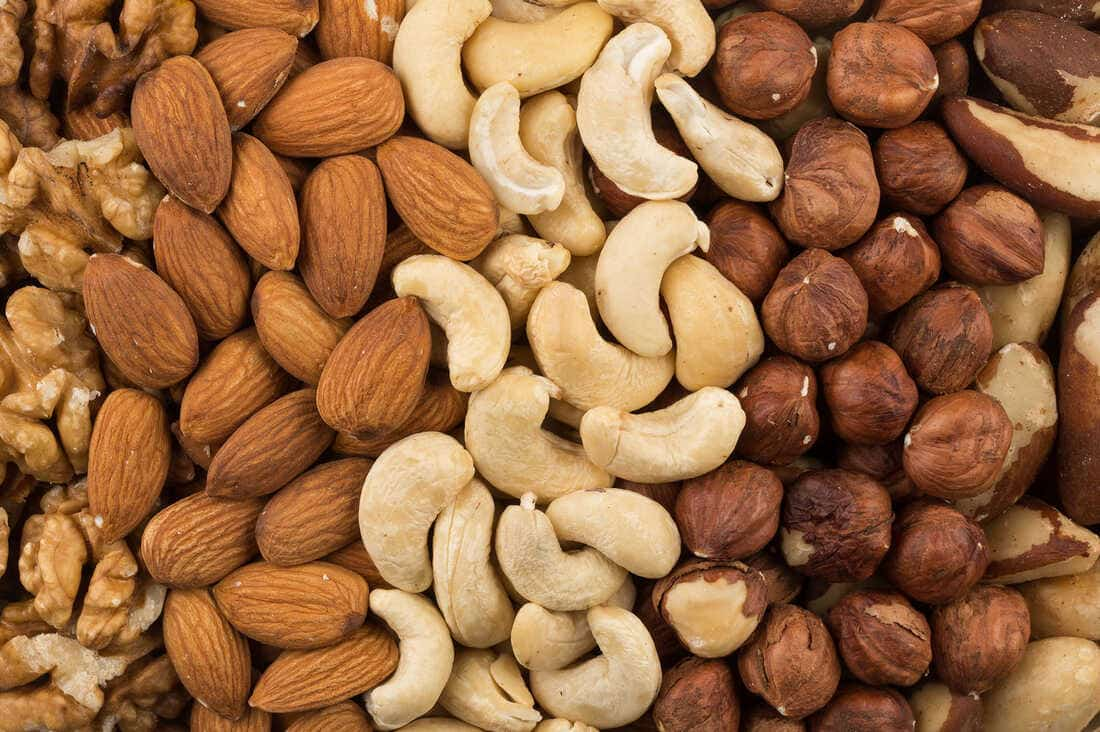Nuts are a great source of healthy fats, fiber, and protein, and are rich in many important nutrients and antioxidants. However, some wonder if roasting nuts have any effect on their nutritional value. This article examines in depth which variety of nuts is healthier and makes a comparison between roasted and raw nuts.

Raw Nuts
Raw nuts are essentially nuts that are unprocessed and have not undergone any form of cooking, roasting, or blanching. This natural state means they retain all of their original nutritional content, making them a powerhouse of essential nutrients.

When we talk about raw nuts, we’re referring to a variety of nuts such as almonds, cashews, walnuts, and hazelnuts, each offering its unique set of benefits. For instance, raw almonds are known for their high levels of Vitamin E, which is crucial for skin health, while walnuts are celebrated for their omega-3 fatty acids, beneficial for heart health.
One of the primary advantages of raw nuts is their contribution to a healthy diet. Being rich in fiber, they aid in digestion and help in maintaining a healthy gut. They’re also a great source of healthy fats, proteins, and various minerals like magnesium and selenium, contributing to overall wellness. Regular consumption of raw nuts can be linked to a reduced risk of chronic diseases such as heart disease and diabetes.
However, it’s important to consume raw nuts in moderation. Despite their health benefits, they are high in calories, and overeating can lead to weight gain. Additionally, some individuals might find raw nuts harder to digest due to the presence of natural substances that can interfere with nutrient absorption. Soaking or sprouting raw nuts can help in reducing these substances, making them more digestible and their nutrients more bioavailable.
Roasted Nuts
Roasted nuts, unlike their raw counterparts, have been cooked—either dry roasted or oil roasted. This process often enhances the flavor, making them more appealing to many consumers. Roasting nuts at a high temperature induces a Maillard reaction, which is responsible for the change in color and the development of a rich, savory flavor. This can make them a more tempting snack option compared to raw nuts, potentially increasing nut consumption among people who may not prefer the taste of raw nuts.

There are two primary methods of roasting: dry roasting and oil roasting. Dry roasting is done without any added fat, whereas oil roasting involves roasting the nuts in oil. Each method has its own impact on the nutritional profile of the nuts. Generally, roasting can slightly decrease the vitamin content, particularly heat-sensitive nutrients like Vitamin E. However, it can also make some nutrients more bioavailable and reduce the presence of phytates, which can hinder the absorption of minerals.
Roasted nuts are often seasoned with salt or other flavorings, which can add to their taste appeal. However, it’s crucial to be mindful of the sodium content, especially if they are heavily salted. Excess sodium intake is linked to high blood pressure and other health issues. Also, if roasted with added fats, the calorie content of the nuts can increase, which is something to consider for those monitoring their calorie intake.

both raw and roasted nuts have their unique properties and benefits. Raw nuts are excellent for those seeking the most natural and unaltered nutrient profile, while roasted nuts offer enhanced flavor and can be more palatable to some, potentially encouraging higher consumption of these nutritionally dense snacks. As with any food, moderation and variety are key to enjoying their benefits as part of a balanced diet.
Why Are Nuts Roasted?
Most of the time, nuts are roasted to improve their taste, aroma, and crunch. Except for pistachios, which are frequently roasted in their shell, the majority of nuts are roasted without their shells.

There are two main kinds of roasting:
- Dry roasting: Roasting without any oil.
Oil roasting, in contrast to dry roasting, involves cooking the nuts in oil, typically in a large vat or fryer. This method not only imparts a different flavor and texture compared to dry roasting but also creates a product that’s often perceived as more indulgent and palatable. The oil used for roasting can vary, with common choices including peanut oil, almond oil, and even specialized flavored or infused oils. The choice of oil can add an additional layer of flavor to the nuts.
During oil roasting, the nuts are fully submerged in hot oil, which cooks them quickly and evenly. This method of roasting tends to make the nuts more tender and moist compared to dry roasting. The oil also acts as a binding agent for salt and other seasonings, which can enhance the taste. However, this also means that oil-roasted nuts typically have a higher calorie and fat content than their dry-roasted counterparts, something that should be considered by those mindful of their fat intake.
The oil roasting process can also affect the nuts’ nutritional profile. While it can similarly reduce the levels of phytic acid, the additional oil can increase the nuts’ overall fat content, though it’s primarily the healthy unsaturated type. The type of oil used can also contribute beneficial nutrients. For example, using almond oil can add vitamin E, while peanut oil can contribute additional antioxidants.
- Oil roasting: Roasting using oil.
Dry roasting is a method where nuts are heated in a large rotating drum or on a tray without the addition of oil or water. This process intensifies the nut’s natural flavors and results in a distinct, toasty aroma and a crunchier texture. Dry roasting is preferred by many health-conscious consumers as it avoids the addition of extra fats and calories that come from oil. This method is particularly popular for nuts like almonds, peanuts, and cashews, which have inherent oils that are released during the roasting process, enhancing their flavor.
The process of dry roasting requires precise temperature control and timing to ensure that the nuts are evenly roasted without burning. The heat triggers the Maillard reaction, a chemical process that occurs between amino acids and reducing sugars, giving the nuts a browned appearance and a more complex flavor profile. It’s this reaction that contributes to the rich, savory taste that makes dry-roasted nuts such a popular snack.
Moreover, dry roasting can have nutritional benefits. The heat can reduce the levels of phytic acid, a natural substance found in nuts that can inhibit the absorption of minerals like iron and zinc. By decreasing the phytic acid content, the nutrients in nuts become more bioavailable, meaning the body can absorb them more easily.
However, while dry roasting enhances flavor and crunch, it’s important to note that it can slightly reduce the content of some heat-sensitive nutrients, such as Vitamin E. Nonetheless, dry-roasted nuts still remain a nutritious snack option, offering a good balance of healthy fats, protein, fiber, and various vitamins and minerals.
both dry and oil roasting methods offer unique advantages and result in distinct flavor profiles and textures. Dry roasting is typically chosen for a more natural, toasty flavor and is better suited for those watching their calorie and fat intake. Oil roasting, on the other hand, provides a richer flavor and a more tender texture, making it a favorite for creating gourmet-flavored nuts and for those who don’t mind the extra calories from the oil. Both methods enhance the natural deliciousness of nuts, making them appealing to a wide range of consumers.
Similar Nutrient Content:
Nuts undergo structural and chemical changes when roasted. More specifically, it changes their color and makes them less moist, which makes them crunchy.
Nuts that have been dry-roasted and raw share very similar amounts of protein, carbs, and fat. Even though roasted nuts contain slightly more calories and fat per gram, the difference is negligible.
besides, Nuts lose some moisture when roasted. As a result, a roasted nut is lighter than a raw one. This explains why roasted nuts have slightly more fat per ounce.
Moreover, raw and roasted nuts’ protein and carb contents are very similar. Nevertheless, roasted nuts can be slightly higher or lower in these macronutrients, depending on the type of nut.
|
Almond |
Amount (g) |
Calories |
Fat (g) |
| Raw |
28 |
161 |
14 |
| Roasted |
167 |
15 |
|
Pecan |
Amount (g) |
Calories |
Fat (g) |
| Raw |
28 |
193 |
20 |
|
Roasted |
199 |
21 |
Roasting Might Damage the Healthy Fats in Nuts;
Nuts are high in monounsaturated and polyunsaturated fats. These healthy fats can lower blood cholesterol and may protect against heart disease.
Impact of High Temperatures and Long Cooking Times
The process of roasting nuts at high temperatures and for extended periods can significantly impact their nutritional quality, particularly concerning the stability of their fats. Nuts are rich in polyunsaturated fats, which are healthy in their natural state but can be susceptible to oxidation when exposed to high heat. This oxidation process is a chemical reaction that not only degrades the quality of the fats but also leads to the formation of harmful compounds known as free radicals. These free radicals are unstable molecules that can cause cellular damage, contributing to various health issues, including inflammation and chronic diseases.
The risk of oxidation is particularly high in nuts with a higher content of polyunsaturated fats, like walnuts and pine nuts. When these nuts are roasted at high temperatures, the heat can cause the unsaturated bonds in the fats to break down, leading to the formation of these free radicals. The longer the nuts are exposed to high heat, the greater the likelihood and extent of this oxidative damage. This is not only a health concern but can also affect the taste and aroma of the nuts, leading to an undesirable “off” flavor and smell, indicative of rancidity.
Controlling the Roasting Process
Given the risks associated with high-temperature roasting, controlling the roasting process becomes crucial to preserve the nutritional integrity and sensory qualities of nuts. Research suggests that roasting nuts at a lower temperature for a shorter duration can significantly mitigate the risk of oxidation. By using a gentle roasting process, it’s possible to maintain the delicate balance of enhancing flavor and texture while minimizing the detrimental effects on the nuts’ fats.
This approach to roasting involves carefully selecting the temperature and monitoring the cooking time to ensure that the nuts are heated just enough to achieve the desired flavor and crunch without overheating. Roasting at a lower temperature helps in preserving the essential fatty acids in the nuts and preventing the formation of rancid fat and free radicals. The optimal temperature and time can vary depending on the type of nut, but generally, temperatures ranging from 120°C to 160°C (248°F to 320°F) are considered safe and effective.
Benefits of Controlled Roasting
The benefits of controlled roasting extend beyond just preserving the nutritional quality of nuts. This method also ensures that the nuts retain their natural flavors and aromas, which can be overshadowed by the unpleasant taste and smell of oxidation when roasted at high temperatures. By preventing the fats within the nuts from becoming rancid, the shelf life of the nuts is also extended, making them a more enjoyable and safer option for consumers.
controlled roasting can enhance the bioavailability of certain nutrients. For instance, the process can reduce the levels of phytic acid, a compound that naturally occurs in nuts and can inhibit the absorption of minerals. By carefully roasting nuts, it becomes possible to unlock more of their nutritional benefits while ensuring they remain a delicious and healthful snack. In summary, controlled roasting strikes a delicate balance, offering a method to enjoy the enhanced taste and texture of roasted nuts without compromising their health benefits and sensory qualities.
Oxidation During Storage
Oxidation of polyunsaturated fats in nuts during storage is a significant concern, especially for roasted nuts. The process of roasting alters the physical structure of nuts, often making them more porous or brittle compared to their raw counterparts. This structural change increases the surface area exposed to air, thereby facilitating greater contact between the fats in the nuts and oxygen in the environment. As a result, the polyunsaturated fats, which are more abundant in certain nuts like walnuts, are prone to oxidative degradation over time when stored.
This susceptibility to oxidation is not just a chemical concern but also impacts the sensory and nutritional quality of the nuts. Oxidized fats can lead to off-flavors, often described as rancid, which significantly diminishes the taste and appeal of the nuts. From a health perspective, the consumption of oxidized fats is undesirable as they can contain harmful compounds that may contribute to various health issues, including increased inflammation and risk of chronic diseases.
Impact on Shelf Life
The propensity of roasted nuts to undergo oxidation during storage directly impacts their shelf life. Since the roasting process makes the fats within nuts more accessible to oxygen, roasted nuts tend to have a shorter shelf life compared to raw nuts. This is a crucial consideration for both consumers and suppliers in terms of storage and consumption timelines.
To maximize the shelf life and maintain the quality of roasted nuts, it’s important to store them properly. This involves keeping them in airtight containers to minimize their exposure to air and thus oxygen. Additionally, storing them in cool, dark places can further slow down the oxidation process. Refrigeration or even freezing can extend their shelf life significantly.
Best Practices for Storage
Understanding the best practices for storing roasted nuts can greatly help in preserving their quality. Consumers should ideally purchase roasted nuts in quantities they can consume within a short period to ensure they are enjoying them at their best. If larger quantities are purchased or if the nuts are intended for use over an extended period, dividing them into smaller, consumable portions and storing them in airtight containers in the refrigerator or freezer can be a wise approach.
For suppliers, packaging plays a pivotal role in preserving the shelf life of roasted nuts. Packaging that limits exposure to air, light, and moisture can significantly reduce the rate of oxidation. Vacuum-sealed packaging or packages with nitrogen flushing are effective methods to extend the shelf life of roasted nuts.
while roasted nuts offer a delightful taste and texture, their storage requires careful consideration to prevent oxidation. By understanding and implementing proper storage techniques, both consumers and suppliers can ensure that the nuts retain their desirable qualities for as long as possible, making them a nutritious and enjoyable part of the diet.

Some Nutrients Are Lost in Roasted Nuts;
Nuts are a great source of nutrients, including vitamin E, magnesium, and phosphorus. They’re also loaded with antioxidants. Some of these nutrients are sensitive to heat and might be lost during the roasting process.
Some types of antioxidants are destroyed during roasting. Since antioxidants help shield your cells from damage caused by free radicals, they are essential to your health.
Carotenoids, vitamin E, and thiamine are also lost during roasting, according to studies. However, the type of nut and the roasting temperature determine the extent of the loss.
One study found that roasting hazelnuts and almonds lost more vitamins than roasting hazelnuts did, while almost no vitamin loss occurred during the pistachio roasting process. Depending on the type of nut and the roasting conditions, each nutrient and its overall response to roasting vary.
Even though roasting depletes some vitamins, nuts are not the primary source of these vitamins. Almonds, which are rich in vitamin E, are the one exception to this rule.
Which Type Should You Eat?
The short answer is both.
Raw nuts are very healthy, but they might contain harmful bacteria. However, even if they do, it is highly unlikely that it will result in an illness.
On the other hand, roasted nuts may have fewer vitamins and antioxidants. Acrylamide may form, but not in harmful quantities, and some of their healthy fats may also be damaged.
and then When nuts are roasted for approximately 15 minutes at a low-to-medium temperature of approximately 284°F, vitamin loss is minimized, healthy fats are unaffected, and the formation of acrylamide is reduced. which also this temperature creates the most likable taste and texture.

Shahkar Corporation: Your Source for Premium Quality Nuts
In the context of understanding the nuances of nut storage and the implications of oxidation, it’s essential to choose a reliable source for both raw and roasted nuts. Shahkar Corporation stands out as a provider of premium quality nuts, offering a wide selection of both raw and expertly roasted nuts that cater to diverse preferences and health considerations.
At Shahkar, we are committed to ensuring that our nuts are of the highest quality from the moment they are harvested to when they reach your table. We understand the delicate balance required in the roasting process to enhance flavor while preserving the nutritional integrity of the nuts. Our roasting techniques are carefully calibrated to provide the perfect crunch and flavor, ensuring that you enjoy the best of what nuts have to offer.
Furthermore, we take storage seriously. Our packaging is designed to minimize exposure to air, light, and moisture, thereby reducing the rate of oxidation and extending the shelf life of our products. This commitment to quality storage means that when you purchase our roasted nuts, you’re receiving them at their peak freshness and flavor.
Our selection includes a variety of nuts, catering to different tastes and dietary needs. From the heart-healthy omega-3 rich walnuts to protein-packed almonds, our range includes both raw and roasted options. Whether you are looking for a nutritious snack, a healthful addition to your meals, or ingredients for your culinary creations, Shahkar Corporation has you covered.
We invite you to explore our selection on our website, Shahkar.de, where you can find detailed information about each product, including their nutritional profiles and suggested uses. Our website is designed to provide a seamless shopping experience, allowing you to easily order our high-quality nuts from the comfort of your home.
Choose Shahkar Corporation for your nut needs, and experience the perfect blend of taste, nutrition, and quality in every bite. Our dedication to excellence ensures that whether you prefer the natural goodness of raw nuts or the rich flavor of roasted nuts, you’ll find exactly what you’re looking for with us.









